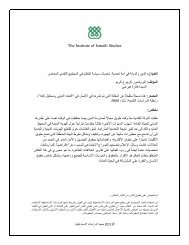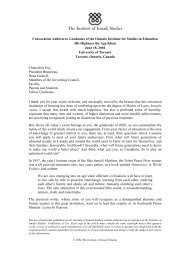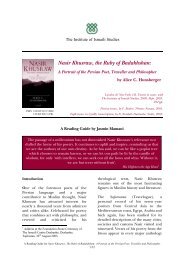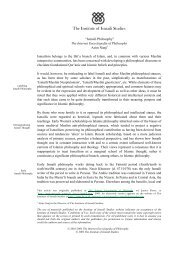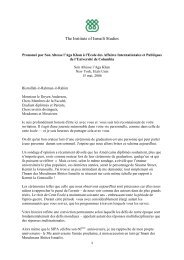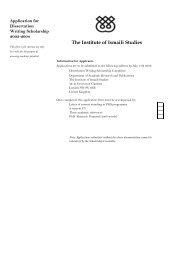The Institute of Ismaili Studies 1
The Institute of Ismaili Studies 1
The Institute of Ismaili Studies 1
Create successful ePaper yourself
Turn your PDF publications into a flip-book with our unique Google optimized e-Paper software.
settled in ‘Askar Mukram, in Khuzistan, where he lived as a wealthy merchant. From there he began<br />
to organise a reinvigorated <strong>Ismaili</strong> da‘wa sending da‘is to different districts around Khuzistan. At an<br />
unknown date, still in the first half <strong>of</strong> the 3rd AH/9th CE century, Imam ‘Abd-Allah found refuge in<br />
Syria, where he eventually re-established contact with some <strong>of</strong> his da‘is, and settled in Salamiya,<br />
continuing to pose as a Hashimid merchant. Henceforth, Salamiya, situated some 35 km southeast <strong>of</strong><br />
Hama, served as the secret headquarters <strong>of</strong> the <strong>Ismaili</strong> da‘wa. <strong>The</strong> efforts <strong>of</strong> Imam ‘Abd-Allah and his<br />
successors began to bear fruit in the 260s AH/870s CE, when numerous da‘is appeared in Iraq and<br />
adjacent regions. It was around 261 AH/874 CE that Hamdan Qarmat was converted to <strong>Ismaili</strong>sm by<br />
the da‘i Husayn Ahvazi (Ibn al-Nadim, ed. Tajaddud, p. 238; Mas‘udi, Tanbih, p. 395). Hamdan, in<br />
turn, organised the da‘wa in the Sawad <strong>of</strong> Kufa, his native locality, and in other districts <strong>of</strong> southern<br />
Iraq. Hamdan’s chief assistant was his brother-in-law ‘Abdan. A learned theologian, ‘Abdan enjoyed<br />
a certain degree <strong>of</strong> independence and was responsible for training and appointing numerous da‘is,<br />
including Abu Sa‘id Jannabi, who later founded the Qarmati state <strong>of</strong> Bahrain.<br />
Centred on the expectation <strong>of</strong> the imminent return <strong>of</strong> Imam Muhammad b. Isma‘il as the Mahdi who<br />
would establish justice in the world, the revolutionary and messianic <strong>Ismaili</strong> movement appealed to<br />
underprivileged groups <strong>of</strong> different social backgrounds. It achieved particular success among the<br />
Imami Shi‘i who were disillusioned with the quietist policies <strong>of</strong> their imams and were left without a<br />
manifest imam after the death <strong>of</strong> the eleventh Imam, Abu Muhammad Hasan al-‘Askari (d. 260 AH/<br />
874 CE). It was under such circumstances that Hamdan won many supporters in southern Iraq and<br />
embarked on his anti-‘Abbasid activities (Ibn al-Dawadari, VI, pp. 44 ff.; Maqrizi, Itte‘az, I, pp. 151<br />
ff.; Nuwayri, XXV, pp. 189 ff.; Tabari, III, pp. 2124, 2126-27; Tabari, tr. XXXVII, pp. 169,171-73).<br />
<strong>The</strong> <strong>Ismaili</strong>s <strong>of</strong> southern Iraq became generally known as the Qaramita or Carmatians, named after<br />
their first chief local leader. This term was soon applied to other <strong>Ismaili</strong> communities not organised by<br />
Hamdan and ‘Abdan. At the time, there was a single <strong>Ismaili</strong> movement directed from Salamiya in the<br />
name <strong>of</strong> Imam Muhammad b. Isma‘il as the Mahdi (Stern, 1961, pp. 99-108; Madelung, 1961, pp. 43-<br />
65). In fact, in order to prepare the ground for the emergence <strong>of</strong> the Mahdi, in 277 AH/890 CE<br />
Hamdan established a dar al-hijra, or abode <strong>of</strong> migration, near Kufa, where his followers gathered<br />
weapons and other provisions. This abode was to serve as the nucleus <strong>of</strong> a new society for the<br />
<strong>Ismaili</strong>s. Similar dar al-hijras were later established for the <strong>Ismaili</strong> communities <strong>of</strong> Yemen, Bahrain<br />
and North Africa. <strong>The</strong> <strong>Ismaili</strong>s (Qarmatis) now referred to their movement simply as al-da‘wa (the<br />
mission) or al-da‘wa al-hadia (the rightly guiding mission), in addition to using expressions such as<br />
da‘wat al-haqq (summons to the truth) or ahl al-haqq (people <strong>of</strong> the truth).<br />
In the meantime, the <strong>Ismaili</strong> da‘wa had appeared in many other regions in the 260s AH /870s CE.<br />
‘Abdan’s brother Ma’mun was active as a da‘i in Fars, where the <strong>Ismaili</strong> converts became known as<br />
the Ma’muniya (Daylami, p. 21). <strong>The</strong> da‘wa in Yemen was initiated by Ibn Hawshab, later known as<br />
Mansur al-Yemen. He arrived there in 268 AH/881 CE, accompanied by his collaborator ‘Ali b. al-<br />
Fazl. By 293 AH/905-6 CE, when ‘Ali occupied San‘a’, these da‘is were in control <strong>of</strong> almost all <strong>of</strong><br />
Yemen (Qadi Nu‘man, Iftitah, pp. 32-54; Janadi, Kitab al-suluk, in Kay, 1892, text pp. 139-52, tr. pp.<br />
191-212). Yemen also served as a base for the extension <strong>of</strong> the da‘wa to other regions. In 270 AH/883<br />
CE, Ibn Hawshab sent his relative Haytham as a da‘i to Sind, initiating the da‘wa on the Indian<br />
subcontinent (Qadi Nu‘man, Iftitah, pp. 45, 47; S. M. Stern, 1949, pp. 298 ff.; Hamdani, 1956). On<br />
Ibn Hawshab’s instructions, the da‘i Abu ‘Abd-Allah al-Shi‘i was active among the Kutama Berbers<br />
<strong>of</strong> Lesser Kabylia in the Maghrib by 280 AH/893 CE. Ibn Hawshab sent other da‘is to Yamama,<br />
Egypt and Bahrayn. After his initial activities in Fars, Abu Sa‘id Jannabi was sent to Bahrayn by<br />
Hamdan and ‘Abdan in 273 AH/886 CE, or a few years later. He rapidly won converts there from<br />
…Please see copyright restrictions on page 1<br />
3



